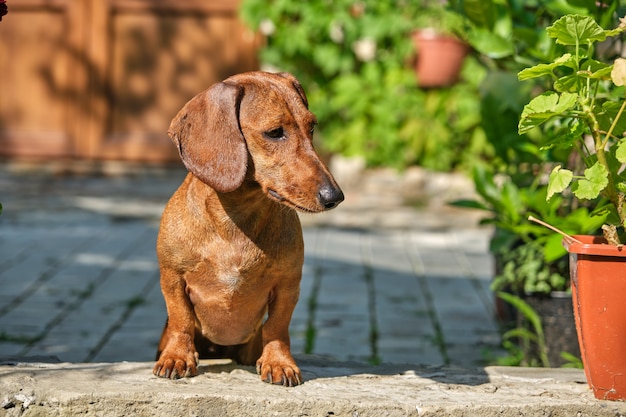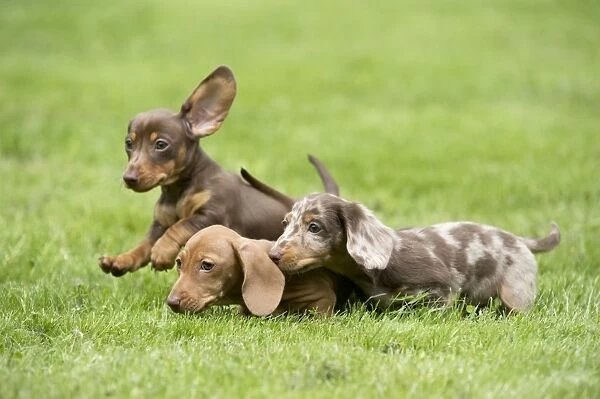The short-haired Dachshund, also known as the standard dachshund, is a beloved breed that has captured the hearts of dog lovers all over the world. With their iconic long bodies, short legs, and charming personality, it’s no wonder why this breed has become so popular. But beyond their physical appearance, what makes the short-haired dachshund such a unique and beloved companion? In this article, we will take a deep dive into the history, temperament, care, and quirks of this iconic breed.
Contents
- 1 Origins and History
- 2 Grooming Your Short-Haired Dachshund: Tips and Tricks
- 3 Exercise and Activity for Short-Haired Dachshunds
- 4 Health Considerations for Short-Haired Dachshunds
- 5 Training and Temperament of Short-Haired Dachshunds
- 6 Finding the Perfect Short-Haired Dachshund: Adoption or Breeding
- 7 Conclusion
Origins and History

The history of the dachshund can be traced back to the 17th century in Germany, where they were bred for a specific purpose – badger hunting. Their name, which translates to “badger dog” in German, highlights their early role as tenacious and fearless hunters. Their long, low-set bodies were ideal for navigating through badger burrows, while their powerful jaws made them formidable adversaries against their prey.
Over time, dachshunds became more than just hunting dogs. They also became popular companions due to their trainability, intelligence, and affectionate nature. The breed’s distinct features, combined with its versatility as both a working dog and a loving pet, contributed significantly to its global popularity.
Grooming Your Short-Haired Dachshund: Tips and Tricks

One of the most appealing aspects of owning a short-haired dachshund is their low-maintenance coat. Unlike some breeds, dachshunds do not require frequent brushing or professional grooming. However, this doesn’t mean that they don’t need any grooming at all. Here are some tips and tricks for keeping your short-haired dachshund looking and feeling their best:
Brushing
While short-haired dachshunds do not shed excessively, they still require occasional brushing to remove dead hair and distribute natural oils throughout their coat. A soft-bristled brush or grooming glove is all you need to keep their coat looking shiny and healthy.
Bathing
Dachshunds have sensitive skin, so it’s essential to use a gentle, hypoallergenic dog shampoo when bathing them. It’s recommended to bathe your dachshund once every 1-3 months, depending on how dirty they get. Over-bathing can strip their coat of essential oils and cause skin irritation.
Nail Trimming
Because dachshunds have short legs and long backs, they are prone to back problems, and overgrown nails can contribute to this issue. Regular nail trimming is necessary to prevent discomfort and maintain proper posture and gait.
Exercise and Activity for Short-Haired Dachshunds

Despite their small size, short-haired dachshunds are an active breed that requires daily exercise and mental stimulation to stay healthy and happy. Here are some ways to keep your dachshund physically and mentally stimulated:
Walks and Hikes
Short walks or hikes are ideal for dachshunds, as they have short legs and may tire easily. However, it’s essential to keep an eye on them and make sure they don’t overexert themselves, especially in hot weather.
Indoor Activities
If the weather is unpleasant or you have limited outdoor space, there are plenty of indoor activities that you can do with your dachshund. These include playing hide-and-seek, teaching new tricks, or setting up obstacle courses with household items.
Interactive Toys
Dachshunds are highly intelligent and enjoy solving puzzles. Interactive toys, such as treat-dispensing ones, are a great way to provide mental stimulation and keep your dachshund occupied.
Health Considerations for Short-Haired Dachshunds

Like all dog breeds, short-haired dachshunds are susceptible to certain health conditions. Being aware of these potential issues can help you take preventive measures and ensure your dachshund’s well-being. Some common health concerns for this breed include:
Back Problems
Due to their long backs and short legs, dachshunds are prone to back problems, such as intervertebral disc disease (IVDD). This condition is caused by the rupturing or bulging of discs in the spine, which can lead to pain, paralysis, and even death.
To prevent back problems, it’s essential to avoid activities that put excessive strain on your dachshund’s back, such as jumping on and off furniture or climbing stairs. It’s also crucial to maintain a healthy weight for your dachshund to reduce pressure on their spine.
Obesity
Dachshunds may be small, but they have big appetites. They are also prone to obesity, which can contribute to many health problems, including joint issues and heart disease. Monitoring your dachshund’s diet and providing regular exercise is crucial in keeping them at a healthy weight.
Dental Issues
Small dogs, including dachshunds, are at risk of dental problems due to overcrowding teeth. Regular dental care, including brushing their teeth and providing dental treats, can help prevent periodontal disease and other oral health issues.
Training and Temperament of Short-Haired Dachshunds

Short-haired dachshunds are intelligent and eager to please, making them relatively easy to train. However, they also have a stubborn streak and may try to assert dominance if not trained correctly. Here are some tips for training your dachshund:
Start Training Early
Early socialization and training are essential for dachshunds to develop into well-adjusted adult dogs. Introduce them to different people, animals, and environments to help them become comfortable and well-behaved in all situations.
Use Positive Reinforcement
Dachshunds respond best to positive reinforcement techniques, such as treats, praise, and playtime. They may shut down or become stubborn if subjected to harsh training methods.
Be Patient and Consistent
Dachshunds can be slow learners, but consistency and patience are key to successful training. It’s essential to establish yourself as the pack leader and set boundaries for your dachshund from the beginning.
Finding the Perfect Short-Haired Dachshund: Adoption or Breeding
If you have decided that a short-haired dachshund is the breed for you, the next step is to find your new furry companion. You have two options – adoption or breeding.
Adoption
Adopting a dachshund from a shelter or rescue organization is a great way to give a dog in need a loving home. You may also find adult dachshunds in need of rehoming due to various reasons, such as their owners’ inability to care for them.
When adopting, make sure to do thorough research on the shelter or rescue organization and ask questions about the dachshund’s history and any potential health or behavioral issues.
Breeding
If you choose to purchase a dachshund from a breeder, it’s crucial to do your due diligence and ensure that you are getting a healthy and well-bred puppy. Look for reputable breeders who prioritize the health and well-being of their dogs and provide proper socialization and training for their puppies.
Conclusion
The short-haired dachshund is a breed that brings joy, laughter, and endless love into their owner’s lives. From their hunting origins in Germany to their popularity as beloved companions today, this breed has captured the hearts of many with their unique personality and charming looks. As with any dog, proper care, training, and attention are vital to ensure a happy and healthy life for your dachshund. But with their unwavering loyalty and big personality, it’s no doubt that the short-haired dachshund will continue to be a beloved breed for years to come.
